Organizational Behavior - Assignment PDF
VerifiedAdded on 2021/06/18
|10
|2848
|46
AI Summary
Contribute Materials
Your contribution can guide someone’s learning journey. Share your
documents today.
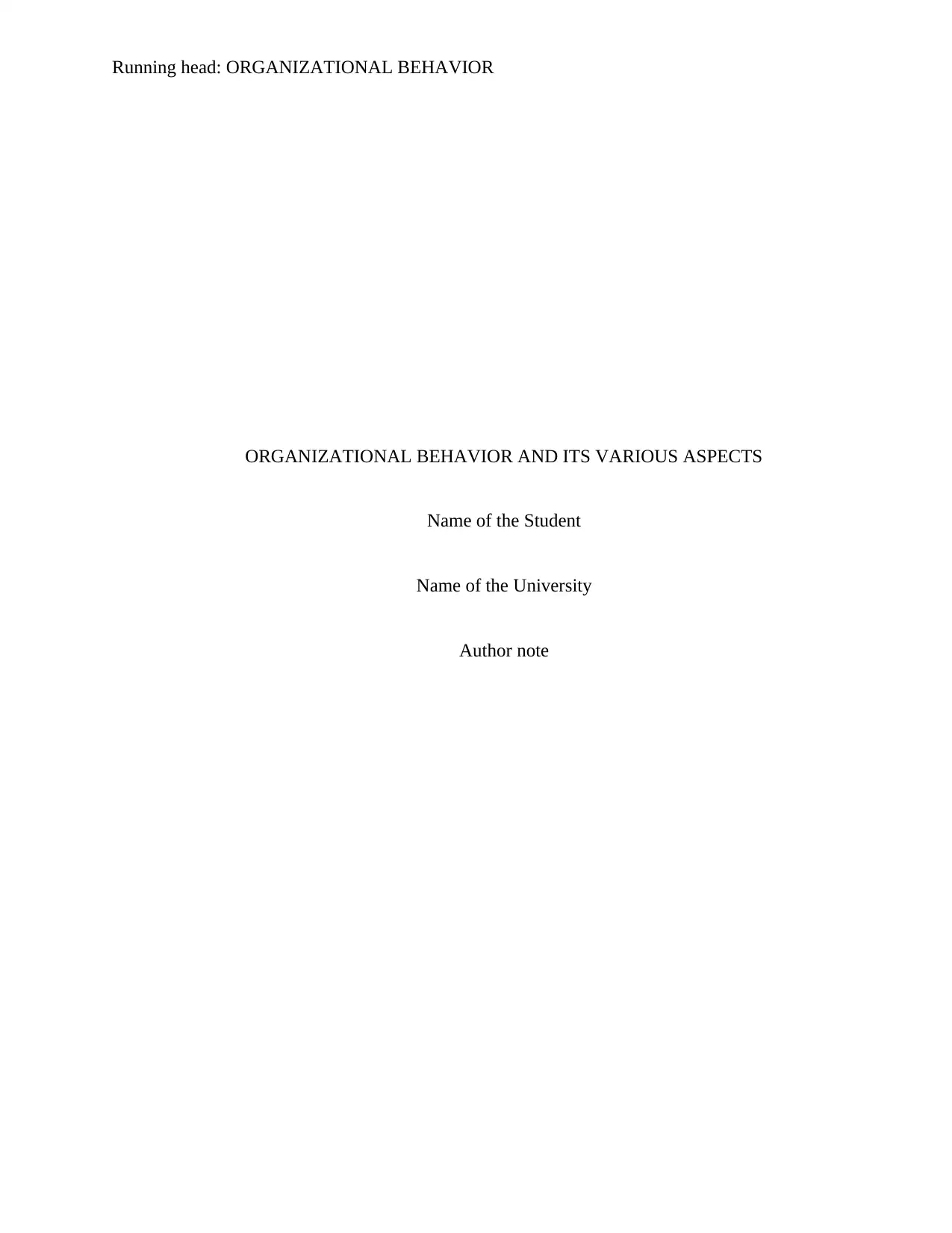
Running head: ORGANIZATIONAL BEHAVIOR
ORGANIZATIONAL BEHAVIOR AND ITS VARIOUS ASPECTS
Name of the Student
Name of the University
Author note
ORGANIZATIONAL BEHAVIOR AND ITS VARIOUS ASPECTS
Name of the Student
Name of the University
Author note
Secure Best Marks with AI Grader
Need help grading? Try our AI Grader for instant feedback on your assignments.
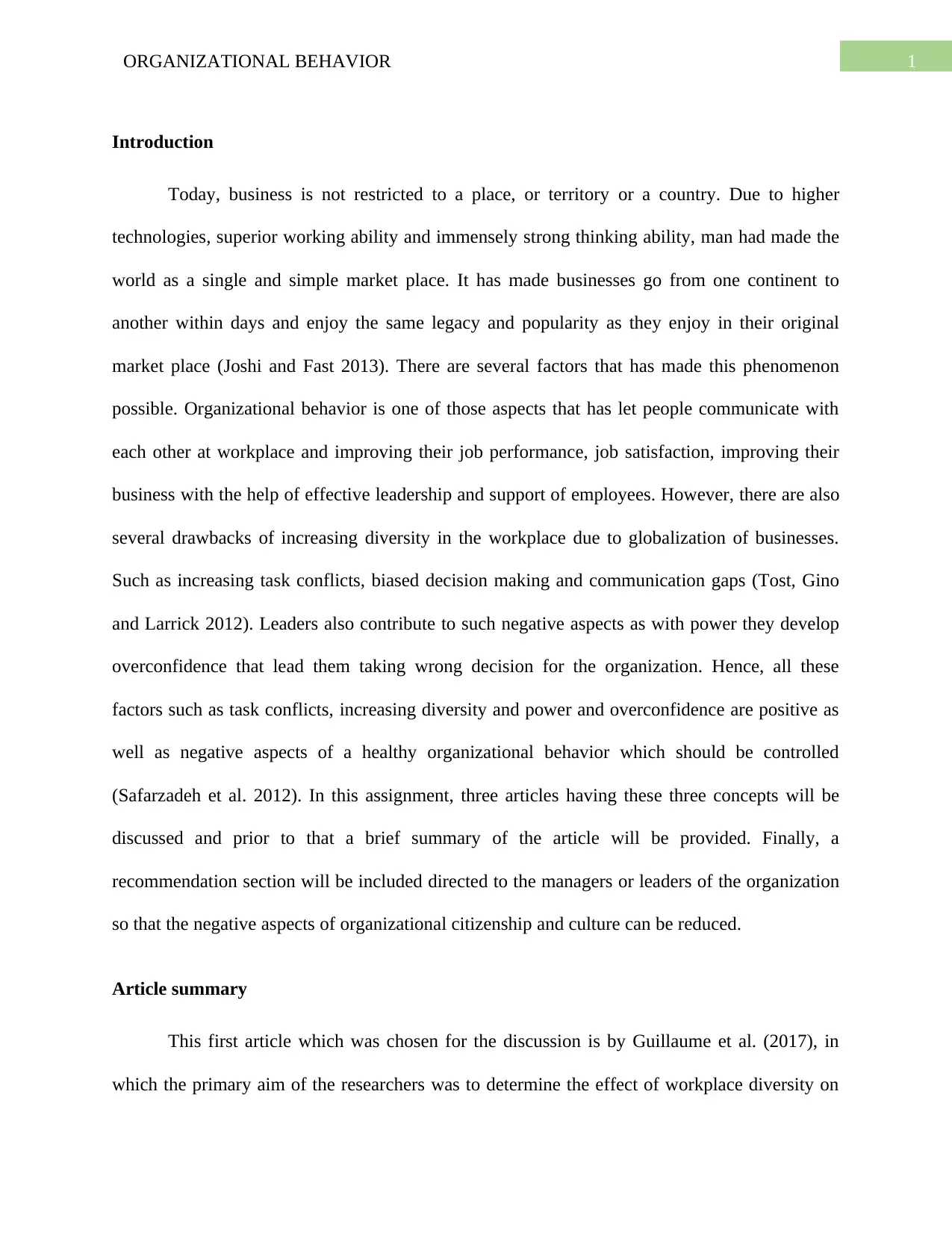
1ORGANIZATIONAL BEHAVIOR
Introduction
Today, business is not restricted to a place, or territory or a country. Due to higher
technologies, superior working ability and immensely strong thinking ability, man had made the
world as a single and simple market place. It has made businesses go from one continent to
another within days and enjoy the same legacy and popularity as they enjoy in their original
market place (Joshi and Fast 2013). There are several factors that has made this phenomenon
possible. Organizational behavior is one of those aspects that has let people communicate with
each other at workplace and improving their job performance, job satisfaction, improving their
business with the help of effective leadership and support of employees. However, there are also
several drawbacks of increasing diversity in the workplace due to globalization of businesses.
Such as increasing task conflicts, biased decision making and communication gaps (Tost, Gino
and Larrick 2012). Leaders also contribute to such negative aspects as with power they develop
overconfidence that lead them taking wrong decision for the organization. Hence, all these
factors such as task conflicts, increasing diversity and power and overconfidence are positive as
well as negative aspects of a healthy organizational behavior which should be controlled
(Safarzadeh et al. 2012). In this assignment, three articles having these three concepts will be
discussed and prior to that a brief summary of the article will be provided. Finally, a
recommendation section will be included directed to the managers or leaders of the organization
so that the negative aspects of organizational citizenship and culture can be reduced.
Article summary
This first article which was chosen for the discussion is by Guillaume et al. (2017), in
which the primary aim of the researchers was to determine the effect of workplace diversity on
Introduction
Today, business is not restricted to a place, or territory or a country. Due to higher
technologies, superior working ability and immensely strong thinking ability, man had made the
world as a single and simple market place. It has made businesses go from one continent to
another within days and enjoy the same legacy and popularity as they enjoy in their original
market place (Joshi and Fast 2013). There are several factors that has made this phenomenon
possible. Organizational behavior is one of those aspects that has let people communicate with
each other at workplace and improving their job performance, job satisfaction, improving their
business with the help of effective leadership and support of employees. However, there are also
several drawbacks of increasing diversity in the workplace due to globalization of businesses.
Such as increasing task conflicts, biased decision making and communication gaps (Tost, Gino
and Larrick 2012). Leaders also contribute to such negative aspects as with power they develop
overconfidence that lead them taking wrong decision for the organization. Hence, all these
factors such as task conflicts, increasing diversity and power and overconfidence are positive as
well as negative aspects of a healthy organizational behavior which should be controlled
(Safarzadeh et al. 2012). In this assignment, three articles having these three concepts will be
discussed and prior to that a brief summary of the article will be provided. Finally, a
recommendation section will be included directed to the managers or leaders of the organization
so that the negative aspects of organizational citizenship and culture can be reduced.
Article summary
This first article which was chosen for the discussion is by Guillaume et al. (2017), in
which the primary aim of the researchers was to determine the effect of workplace diversity on
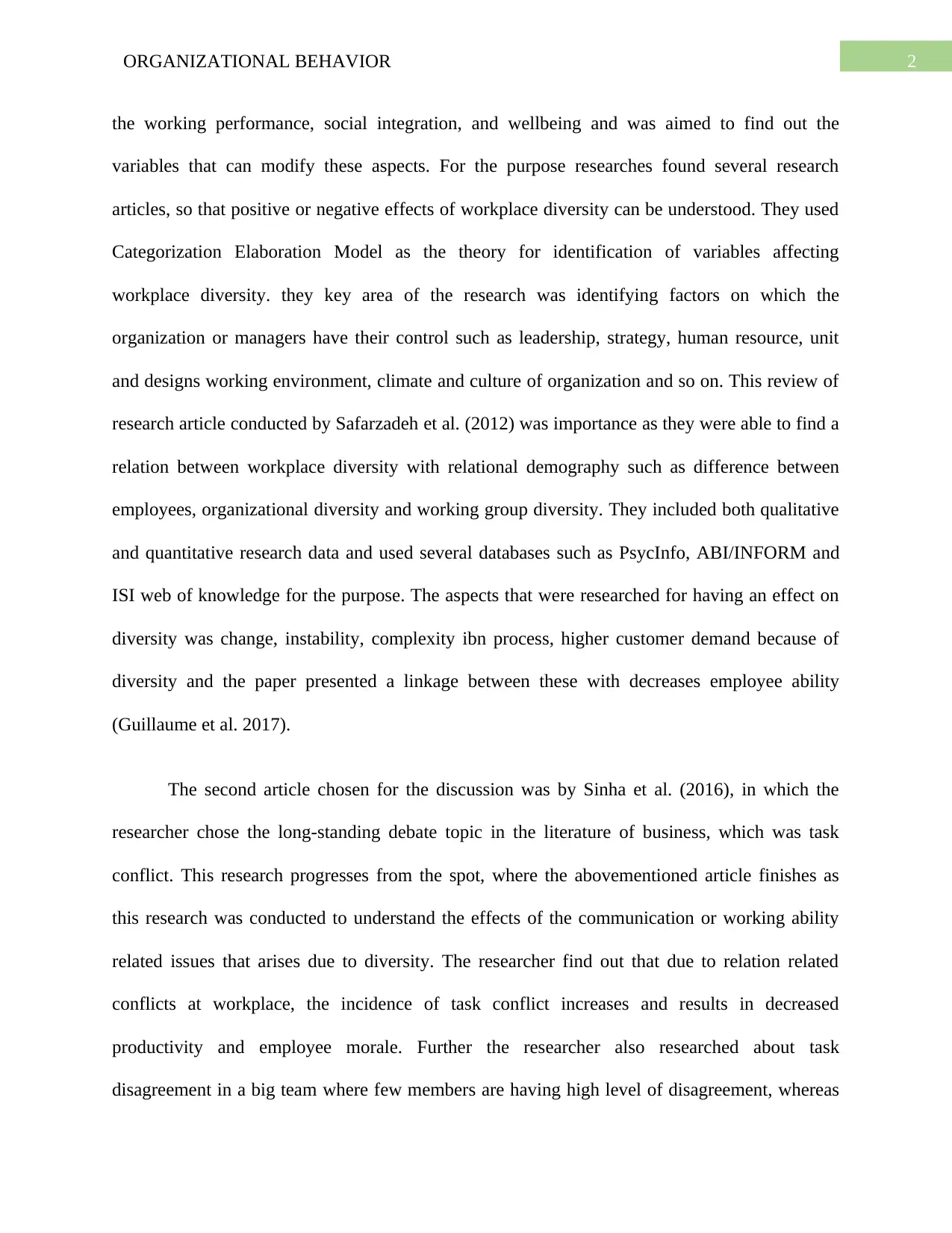
2ORGANIZATIONAL BEHAVIOR
the working performance, social integration, and wellbeing and was aimed to find out the
variables that can modify these aspects. For the purpose researches found several research
articles, so that positive or negative effects of workplace diversity can be understood. They used
Categorization Elaboration Model as the theory for identification of variables affecting
workplace diversity. they key area of the research was identifying factors on which the
organization or managers have their control such as leadership, strategy, human resource, unit
and designs working environment, climate and culture of organization and so on. This review of
research article conducted by Safarzadeh et al. (2012) was importance as they were able to find a
relation between workplace diversity with relational demography such as difference between
employees, organizational diversity and working group diversity. They included both qualitative
and quantitative research data and used several databases such as PsycInfo, ABI/INFORM and
ISI web of knowledge for the purpose. The aspects that were researched for having an effect on
diversity was change, instability, complexity ibn process, higher customer demand because of
diversity and the paper presented a linkage between these with decreases employee ability
(Guillaume et al. 2017).
The second article chosen for the discussion was by Sinha et al. (2016), in which the
researcher chose the long-standing debate topic in the literature of business, which was task
conflict. This research progresses from the spot, where the abovementioned article finishes as
this research was conducted to understand the effects of the communication or working ability
related issues that arises due to diversity. The researcher find out that due to relation related
conflicts at workplace, the incidence of task conflict increases and results in decreased
productivity and employee morale. Further the researcher also researched about task
disagreement in a big team where few members are having high level of disagreement, whereas
the working performance, social integration, and wellbeing and was aimed to find out the
variables that can modify these aspects. For the purpose researches found several research
articles, so that positive or negative effects of workplace diversity can be understood. They used
Categorization Elaboration Model as the theory for identification of variables affecting
workplace diversity. they key area of the research was identifying factors on which the
organization or managers have their control such as leadership, strategy, human resource, unit
and designs working environment, climate and culture of organization and so on. This review of
research article conducted by Safarzadeh et al. (2012) was importance as they were able to find a
relation between workplace diversity with relational demography such as difference between
employees, organizational diversity and working group diversity. They included both qualitative
and quantitative research data and used several databases such as PsycInfo, ABI/INFORM and
ISI web of knowledge for the purpose. The aspects that were researched for having an effect on
diversity was change, instability, complexity ibn process, higher customer demand because of
diversity and the paper presented a linkage between these with decreases employee ability
(Guillaume et al. 2017).
The second article chosen for the discussion was by Sinha et al. (2016), in which the
researcher chose the long-standing debate topic in the literature of business, which was task
conflict. This research progresses from the spot, where the abovementioned article finishes as
this research was conducted to understand the effects of the communication or working ability
related issues that arises due to diversity. The researcher find out that due to relation related
conflicts at workplace, the incidence of task conflict increases and results in decreased
productivity and employee morale. Further the researcher also researched about task
disagreement in a big team where few members are having high level of disagreement, whereas

3ORGANIZATIONAL BEHAVIOR
few are having low levels of disagreement, resulting in intense task disagreement related
conflict. For this purpose, they conducted a research including a group of students and then
engaged them in the nosiness environment and divided in a team so the conflicts and
disagreement among them can be understood. They witnessed that due to task conflicts, their
communication skill hampered and they were not being able to communicate their messages to
each other which could be harmful for the organization (Sinha et al. 2016).
The third article which was included in the assignment was Fast et al. (2012), regarding
the effect of power and emerging overconfidence in leads due to such immense power within the
organization. Further their target was to understand the effect of decisions that was taken due to
over confidence on the organization. For this purpose, they conducted five experiments, so that
the effect of power and overconfident decisions on the organization and their decision can be
understood. Further, measure of work related power and roles of individual with high and low
powers was also researched through this research article. The primary objective was identify the
power and related decision that affect the organization with monetary loss and human resource
related loss. They found that the combination of power and a person not able to bear that power
was severe and the organization had to suffer due to such severe combination. Therefore, through
this research, the researchers established that power should be distributed in an organization in
such a way that people having low power can also question the decisions of higher authority so
that chances of disastrous decision making can be reduced (Fast et al. 2012).
Discussion
While going through these three research and review articles, the primary theme which
was drawn was such that an organization behaves in similar way, the people working in that
few are having low levels of disagreement, resulting in intense task disagreement related
conflict. For this purpose, they conducted a research including a group of students and then
engaged them in the nosiness environment and divided in a team so the conflicts and
disagreement among them can be understood. They witnessed that due to task conflicts, their
communication skill hampered and they were not being able to communicate their messages to
each other which could be harmful for the organization (Sinha et al. 2016).
The third article which was included in the assignment was Fast et al. (2012), regarding
the effect of power and emerging overconfidence in leads due to such immense power within the
organization. Further their target was to understand the effect of decisions that was taken due to
over confidence on the organization. For this purpose, they conducted five experiments, so that
the effect of power and overconfident decisions on the organization and their decision can be
understood. Further, measure of work related power and roles of individual with high and low
powers was also researched through this research article. The primary objective was identify the
power and related decision that affect the organization with monetary loss and human resource
related loss. They found that the combination of power and a person not able to bear that power
was severe and the organization had to suffer due to such severe combination. Therefore, through
this research, the researchers established that power should be distributed in an organization in
such a way that people having low power can also question the decisions of higher authority so
that chances of disastrous decision making can be reduced (Fast et al. 2012).
Discussion
While going through these three research and review articles, the primary theme which
was drawn was such that an organization behaves in similar way, the people working in that
Secure Best Marks with AI Grader
Need help grading? Try our AI Grader for instant feedback on your assignments.
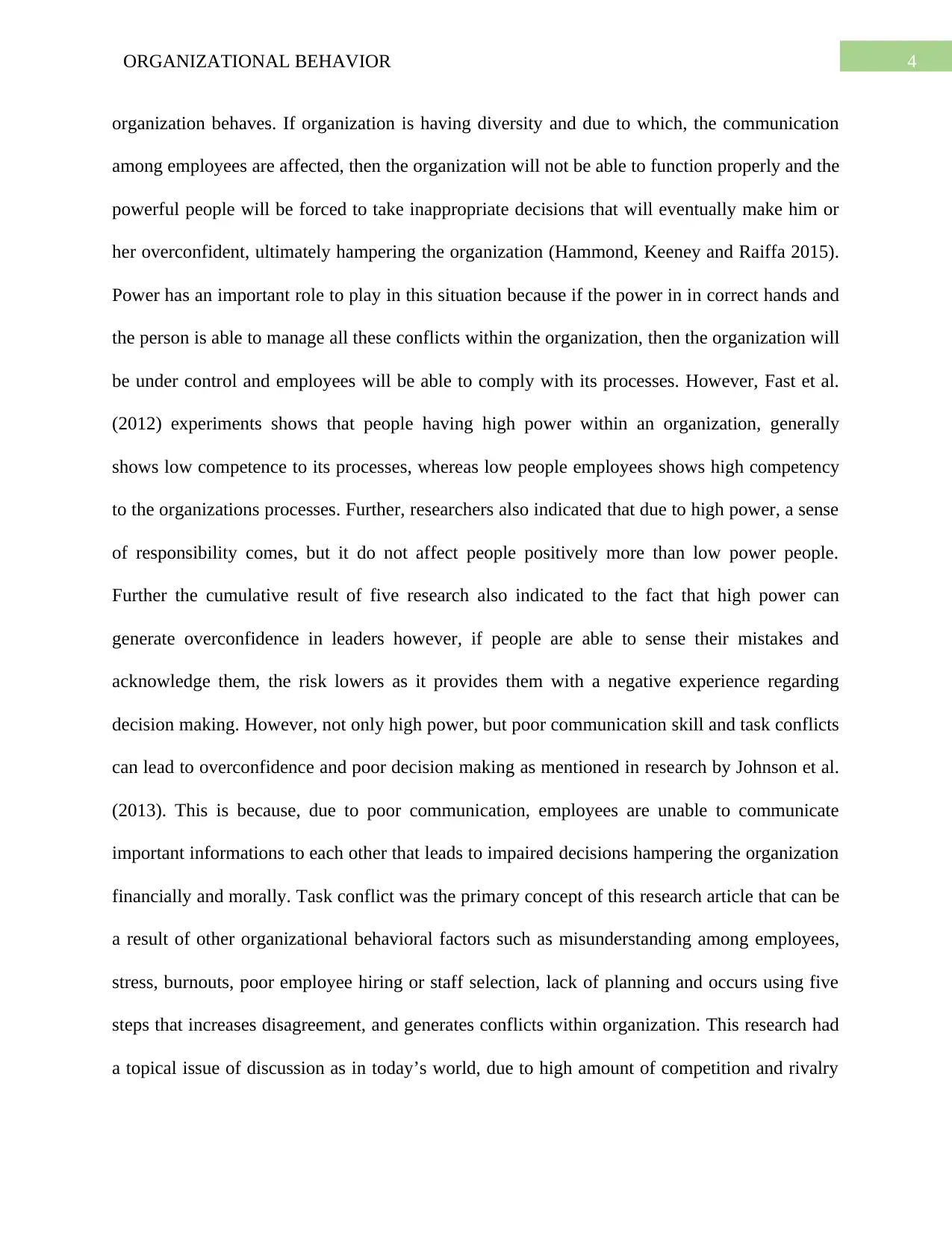
4ORGANIZATIONAL BEHAVIOR
organization behaves. If organization is having diversity and due to which, the communication
among employees are affected, then the organization will not be able to function properly and the
powerful people will be forced to take inappropriate decisions that will eventually make him or
her overconfident, ultimately hampering the organization (Hammond, Keeney and Raiffa 2015).
Power has an important role to play in this situation because if the power in in correct hands and
the person is able to manage all these conflicts within the organization, then the organization will
be under control and employees will be able to comply with its processes. However, Fast et al.
(2012) experiments shows that people having high power within an organization, generally
shows low competence to its processes, whereas low people employees shows high competency
to the organizations processes. Further, researchers also indicated that due to high power, a sense
of responsibility comes, but it do not affect people positively more than low power people.
Further the cumulative result of five research also indicated to the fact that high power can
generate overconfidence in leaders however, if people are able to sense their mistakes and
acknowledge them, the risk lowers as it provides them with a negative experience regarding
decision making. However, not only high power, but poor communication skill and task conflicts
can lead to overconfidence and poor decision making as mentioned in research by Johnson et al.
(2013). This is because, due to poor communication, employees are unable to communicate
important informations to each other that leads to impaired decisions hampering the organization
financially and morally. Task conflict was the primary concept of this research article that can be
a result of other organizational behavioral factors such as misunderstanding among employees,
stress, burnouts, poor employee hiring or staff selection, lack of planning and occurs using five
steps that increases disagreement, and generates conflicts within organization. This research had
a topical issue of discussion as in today’s world, due to high amount of competition and rivalry
organization behaves. If organization is having diversity and due to which, the communication
among employees are affected, then the organization will not be able to function properly and the
powerful people will be forced to take inappropriate decisions that will eventually make him or
her overconfident, ultimately hampering the organization (Hammond, Keeney and Raiffa 2015).
Power has an important role to play in this situation because if the power in in correct hands and
the person is able to manage all these conflicts within the organization, then the organization will
be under control and employees will be able to comply with its processes. However, Fast et al.
(2012) experiments shows that people having high power within an organization, generally
shows low competence to its processes, whereas low people employees shows high competency
to the organizations processes. Further, researchers also indicated that due to high power, a sense
of responsibility comes, but it do not affect people positively more than low power people.
Further the cumulative result of five research also indicated to the fact that high power can
generate overconfidence in leaders however, if people are able to sense their mistakes and
acknowledge them, the risk lowers as it provides them with a negative experience regarding
decision making. However, not only high power, but poor communication skill and task conflicts
can lead to overconfidence and poor decision making as mentioned in research by Johnson et al.
(2013). This is because, due to poor communication, employees are unable to communicate
important informations to each other that leads to impaired decisions hampering the organization
financially and morally. Task conflict was the primary concept of this research article that can be
a result of other organizational behavioral factors such as misunderstanding among employees,
stress, burnouts, poor employee hiring or staff selection, lack of planning and occurs using five
steps that increases disagreement, and generates conflicts within organization. This research had
a topical issue of discussion as in today’s world, due to high amount of competition and rivalry
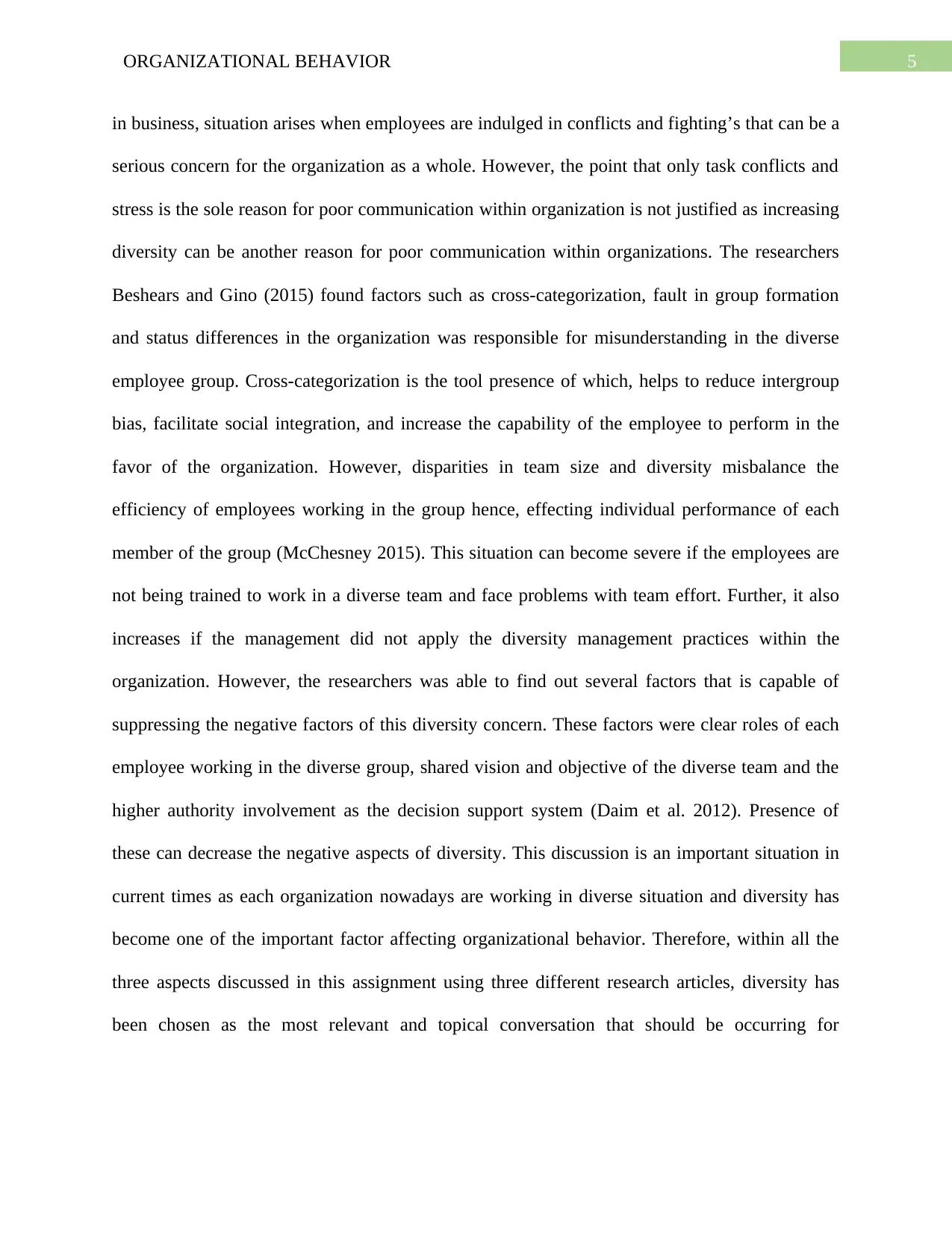
5ORGANIZATIONAL BEHAVIOR
in business, situation arises when employees are indulged in conflicts and fighting’s that can be a
serious concern for the organization as a whole. However, the point that only task conflicts and
stress is the sole reason for poor communication within organization is not justified as increasing
diversity can be another reason for poor communication within organizations. The researchers
Beshears and Gino (2015) found factors such as cross-categorization, fault in group formation
and status differences in the organization was responsible for misunderstanding in the diverse
employee group. Cross-categorization is the tool presence of which, helps to reduce intergroup
bias, facilitate social integration, and increase the capability of the employee to perform in the
favor of the organization. However, disparities in team size and diversity misbalance the
efficiency of employees working in the group hence, effecting individual performance of each
member of the group (McChesney 2015). This situation can become severe if the employees are
not being trained to work in a diverse team and face problems with team effort. Further, it also
increases if the management did not apply the diversity management practices within the
organization. However, the researchers was able to find out several factors that is capable of
suppressing the negative factors of this diversity concern. These factors were clear roles of each
employee working in the diverse group, shared vision and objective of the diverse team and the
higher authority involvement as the decision support system (Daim et al. 2012). Presence of
these can decrease the negative aspects of diversity. This discussion is an important situation in
current times as each organization nowadays are working in diverse situation and diversity has
become one of the important factor affecting organizational behavior. Therefore, within all the
three aspects discussed in this assignment using three different research articles, diversity has
been chosen as the most relevant and topical conversation that should be occurring for
in business, situation arises when employees are indulged in conflicts and fighting’s that can be a
serious concern for the organization as a whole. However, the point that only task conflicts and
stress is the sole reason for poor communication within organization is not justified as increasing
diversity can be another reason for poor communication within organizations. The researchers
Beshears and Gino (2015) found factors such as cross-categorization, fault in group formation
and status differences in the organization was responsible for misunderstanding in the diverse
employee group. Cross-categorization is the tool presence of which, helps to reduce intergroup
bias, facilitate social integration, and increase the capability of the employee to perform in the
favor of the organization. However, disparities in team size and diversity misbalance the
efficiency of employees working in the group hence, effecting individual performance of each
member of the group (McChesney 2015). This situation can become severe if the employees are
not being trained to work in a diverse team and face problems with team effort. Further, it also
increases if the management did not apply the diversity management practices within the
organization. However, the researchers was able to find out several factors that is capable of
suppressing the negative factors of this diversity concern. These factors were clear roles of each
employee working in the diverse group, shared vision and objective of the diverse team and the
higher authority involvement as the decision support system (Daim et al. 2012). Presence of
these can decrease the negative aspects of diversity. This discussion is an important situation in
current times as each organization nowadays are working in diverse situation and diversity has
become one of the important factor affecting organizational behavior. Therefore, within all the
three aspects discussed in this assignment using three different research articles, diversity has
been chosen as the most relevant and topical conversation that should be occurring for
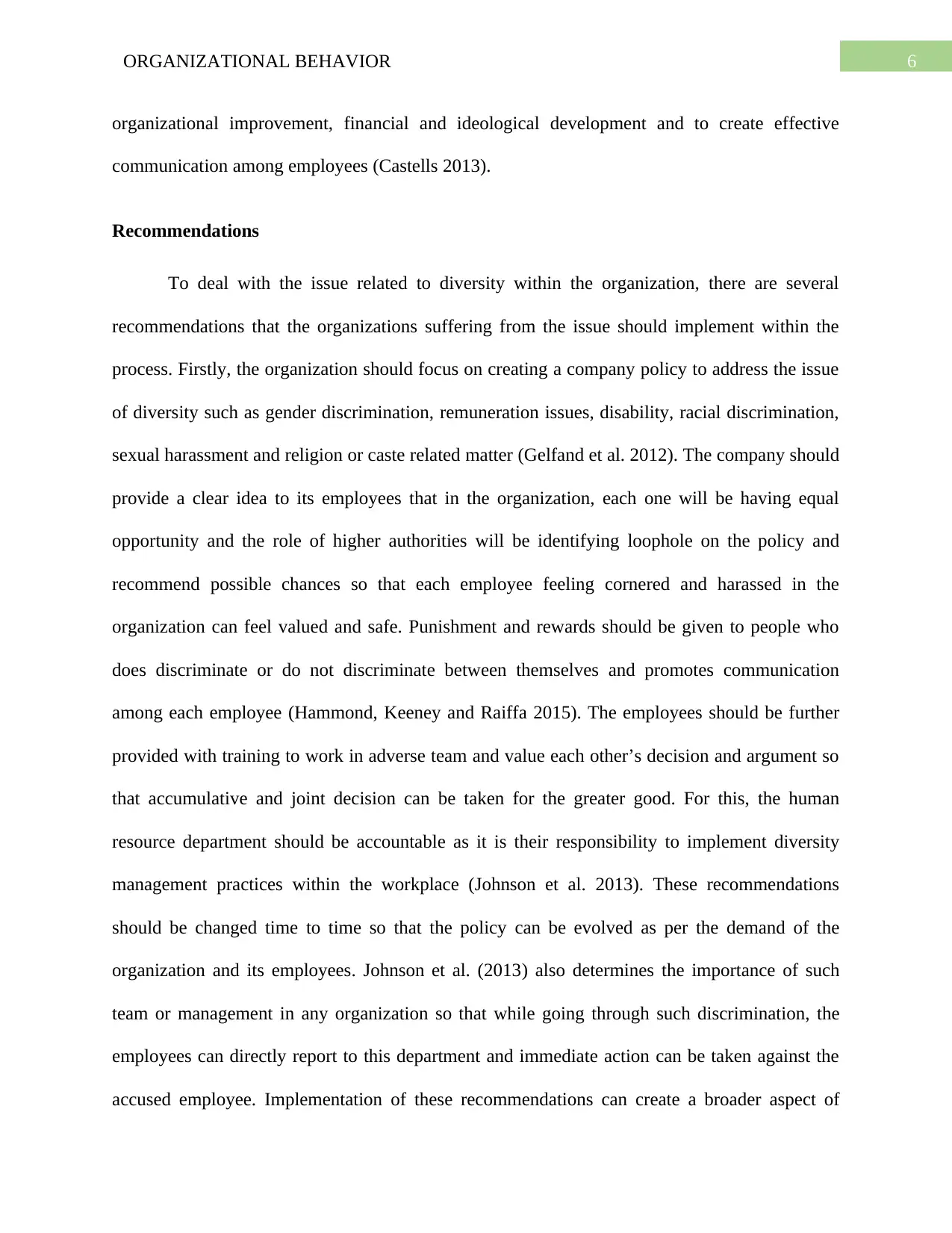
6ORGANIZATIONAL BEHAVIOR
organizational improvement, financial and ideological development and to create effective
communication among employees (Castells 2013).
Recommendations
To deal with the issue related to diversity within the organization, there are several
recommendations that the organizations suffering from the issue should implement within the
process. Firstly, the organization should focus on creating a company policy to address the issue
of diversity such as gender discrimination, remuneration issues, disability, racial discrimination,
sexual harassment and religion or caste related matter (Gelfand et al. 2012). The company should
provide a clear idea to its employees that in the organization, each one will be having equal
opportunity and the role of higher authorities will be identifying loophole on the policy and
recommend possible chances so that each employee feeling cornered and harassed in the
organization can feel valued and safe. Punishment and rewards should be given to people who
does discriminate or do not discriminate between themselves and promotes communication
among each employee (Hammond, Keeney and Raiffa 2015). The employees should be further
provided with training to work in adverse team and value each other’s decision and argument so
that accumulative and joint decision can be taken for the greater good. For this, the human
resource department should be accountable as it is their responsibility to implement diversity
management practices within the workplace (Johnson et al. 2013). These recommendations
should be changed time to time so that the policy can be evolved as per the demand of the
organization and its employees. Johnson et al. (2013) also determines the importance of such
team or management in any organization so that while going through such discrimination, the
employees can directly report to this department and immediate action can be taken against the
accused employee. Implementation of these recommendations can create a broader aspect of
organizational improvement, financial and ideological development and to create effective
communication among employees (Castells 2013).
Recommendations
To deal with the issue related to diversity within the organization, there are several
recommendations that the organizations suffering from the issue should implement within the
process. Firstly, the organization should focus on creating a company policy to address the issue
of diversity such as gender discrimination, remuneration issues, disability, racial discrimination,
sexual harassment and religion or caste related matter (Gelfand et al. 2012). The company should
provide a clear idea to its employees that in the organization, each one will be having equal
opportunity and the role of higher authorities will be identifying loophole on the policy and
recommend possible chances so that each employee feeling cornered and harassed in the
organization can feel valued and safe. Punishment and rewards should be given to people who
does discriminate or do not discriminate between themselves and promotes communication
among each employee (Hammond, Keeney and Raiffa 2015). The employees should be further
provided with training to work in adverse team and value each other’s decision and argument so
that accumulative and joint decision can be taken for the greater good. For this, the human
resource department should be accountable as it is their responsibility to implement diversity
management practices within the workplace (Johnson et al. 2013). These recommendations
should be changed time to time so that the policy can be evolved as per the demand of the
organization and its employees. Johnson et al. (2013) also determines the importance of such
team or management in any organization so that while going through such discrimination, the
employees can directly report to this department and immediate action can be taken against the
accused employee. Implementation of these recommendations can create a broader aspect of
Paraphrase This Document
Need a fresh take? Get an instant paraphrase of this document with our AI Paraphraser
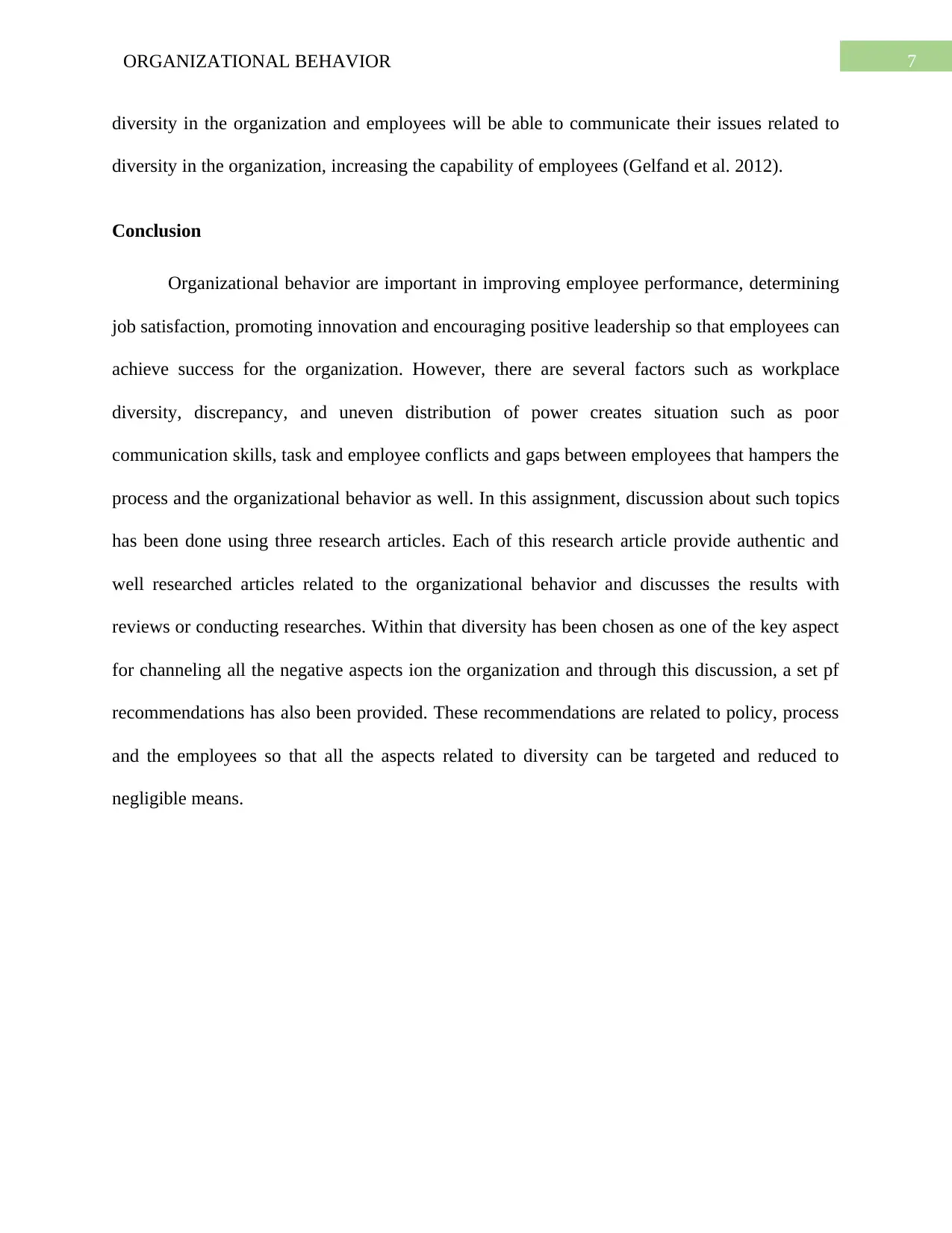
7ORGANIZATIONAL BEHAVIOR
diversity in the organization and employees will be able to communicate their issues related to
diversity in the organization, increasing the capability of employees (Gelfand et al. 2012).
Conclusion
Organizational behavior are important in improving employee performance, determining
job satisfaction, promoting innovation and encouraging positive leadership so that employees can
achieve success for the organization. However, there are several factors such as workplace
diversity, discrepancy, and uneven distribution of power creates situation such as poor
communication skills, task and employee conflicts and gaps between employees that hampers the
process and the organizational behavior as well. In this assignment, discussion about such topics
has been done using three research articles. Each of this research article provide authentic and
well researched articles related to the organizational behavior and discusses the results with
reviews or conducting researches. Within that diversity has been chosen as one of the key aspect
for channeling all the negative aspects ion the organization and through this discussion, a set pf
recommendations has also been provided. These recommendations are related to policy, process
and the employees so that all the aspects related to diversity can be targeted and reduced to
negligible means.
diversity in the organization and employees will be able to communicate their issues related to
diversity in the organization, increasing the capability of employees (Gelfand et al. 2012).
Conclusion
Organizational behavior are important in improving employee performance, determining
job satisfaction, promoting innovation and encouraging positive leadership so that employees can
achieve success for the organization. However, there are several factors such as workplace
diversity, discrepancy, and uneven distribution of power creates situation such as poor
communication skills, task and employee conflicts and gaps between employees that hampers the
process and the organizational behavior as well. In this assignment, discussion about such topics
has been done using three research articles. Each of this research article provide authentic and
well researched articles related to the organizational behavior and discusses the results with
reviews or conducting researches. Within that diversity has been chosen as one of the key aspect
for channeling all the negative aspects ion the organization and through this discussion, a set pf
recommendations has also been provided. These recommendations are related to policy, process
and the employees so that all the aspects related to diversity can be targeted and reduced to
negligible means.
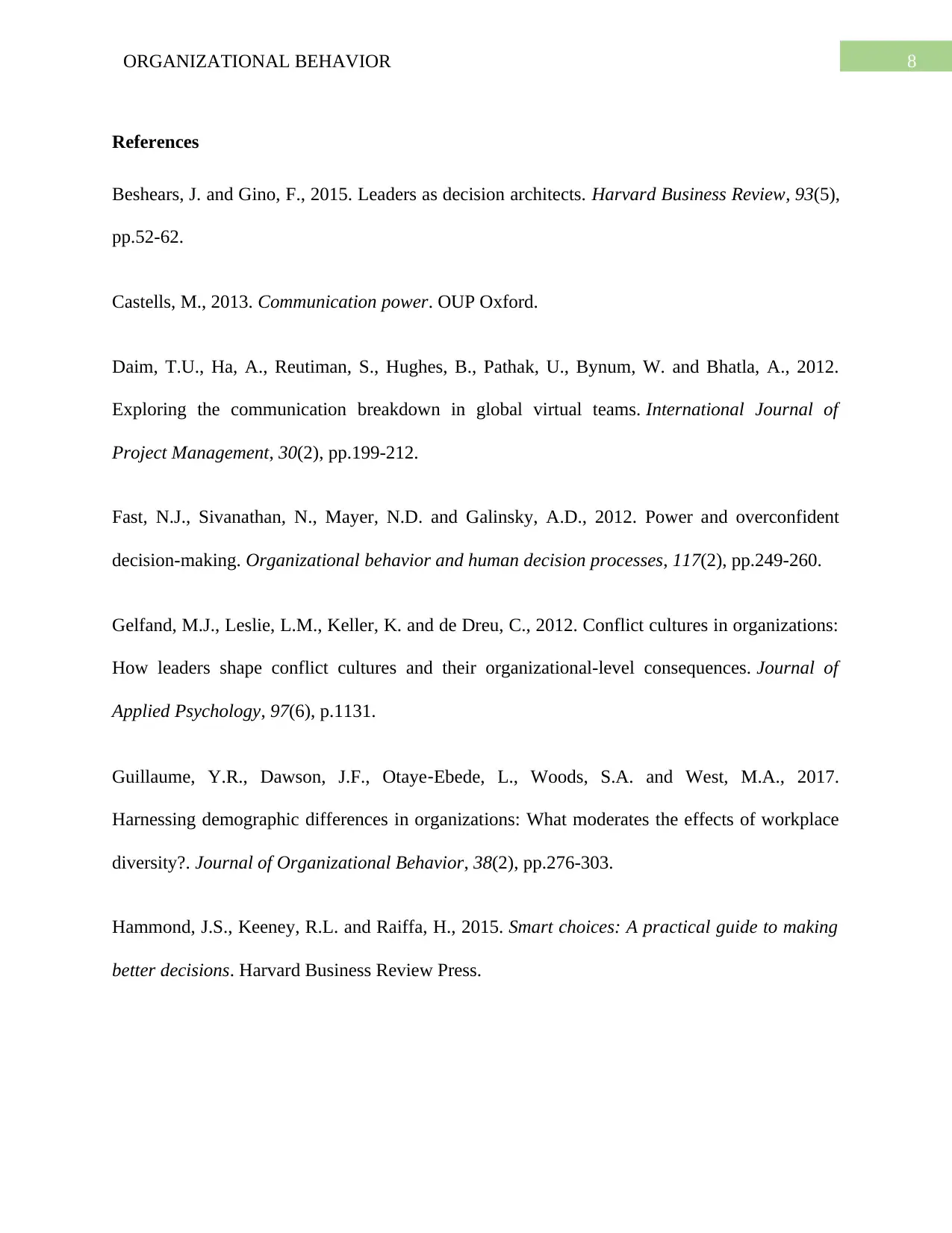
8ORGANIZATIONAL BEHAVIOR
References
Beshears, J. and Gino, F., 2015. Leaders as decision architects. Harvard Business Review, 93(5),
pp.52-62.
Castells, M., 2013. Communication power. OUP Oxford.
Daim, T.U., Ha, A., Reutiman, S., Hughes, B., Pathak, U., Bynum, W. and Bhatla, A., 2012.
Exploring the communication breakdown in global virtual teams. International Journal of
Project Management, 30(2), pp.199-212.
Fast, N.J., Sivanathan, N., Mayer, N.D. and Galinsky, A.D., 2012. Power and overconfident
decision-making. Organizational behavior and human decision processes, 117(2), pp.249-260.
Gelfand, M.J., Leslie, L.M., Keller, K. and de Dreu, C., 2012. Conflict cultures in organizations:
How leaders shape conflict cultures and their organizational-level consequences. Journal of
Applied Psychology, 97(6), p.1131.
Guillaume, Y.R., Dawson, J.F., Otaye‐Ebede, L., Woods, S.A. and West, M.A., 2017.
Harnessing demographic differences in organizations: What moderates the effects of workplace
diversity?. Journal of Organizational Behavior, 38(2), pp.276-303.
Hammond, J.S., Keeney, R.L. and Raiffa, H., 2015. Smart choices: A practical guide to making
better decisions. Harvard Business Review Press.
References
Beshears, J. and Gino, F., 2015. Leaders as decision architects. Harvard Business Review, 93(5),
pp.52-62.
Castells, M., 2013. Communication power. OUP Oxford.
Daim, T.U., Ha, A., Reutiman, S., Hughes, B., Pathak, U., Bynum, W. and Bhatla, A., 2012.
Exploring the communication breakdown in global virtual teams. International Journal of
Project Management, 30(2), pp.199-212.
Fast, N.J., Sivanathan, N., Mayer, N.D. and Galinsky, A.D., 2012. Power and overconfident
decision-making. Organizational behavior and human decision processes, 117(2), pp.249-260.
Gelfand, M.J., Leslie, L.M., Keller, K. and de Dreu, C., 2012. Conflict cultures in organizations:
How leaders shape conflict cultures and their organizational-level consequences. Journal of
Applied Psychology, 97(6), p.1131.
Guillaume, Y.R., Dawson, J.F., Otaye‐Ebede, L., Woods, S.A. and West, M.A., 2017.
Harnessing demographic differences in organizations: What moderates the effects of workplace
diversity?. Journal of Organizational Behavior, 38(2), pp.276-303.
Hammond, J.S., Keeney, R.L. and Raiffa, H., 2015. Smart choices: A practical guide to making
better decisions. Harvard Business Review Press.
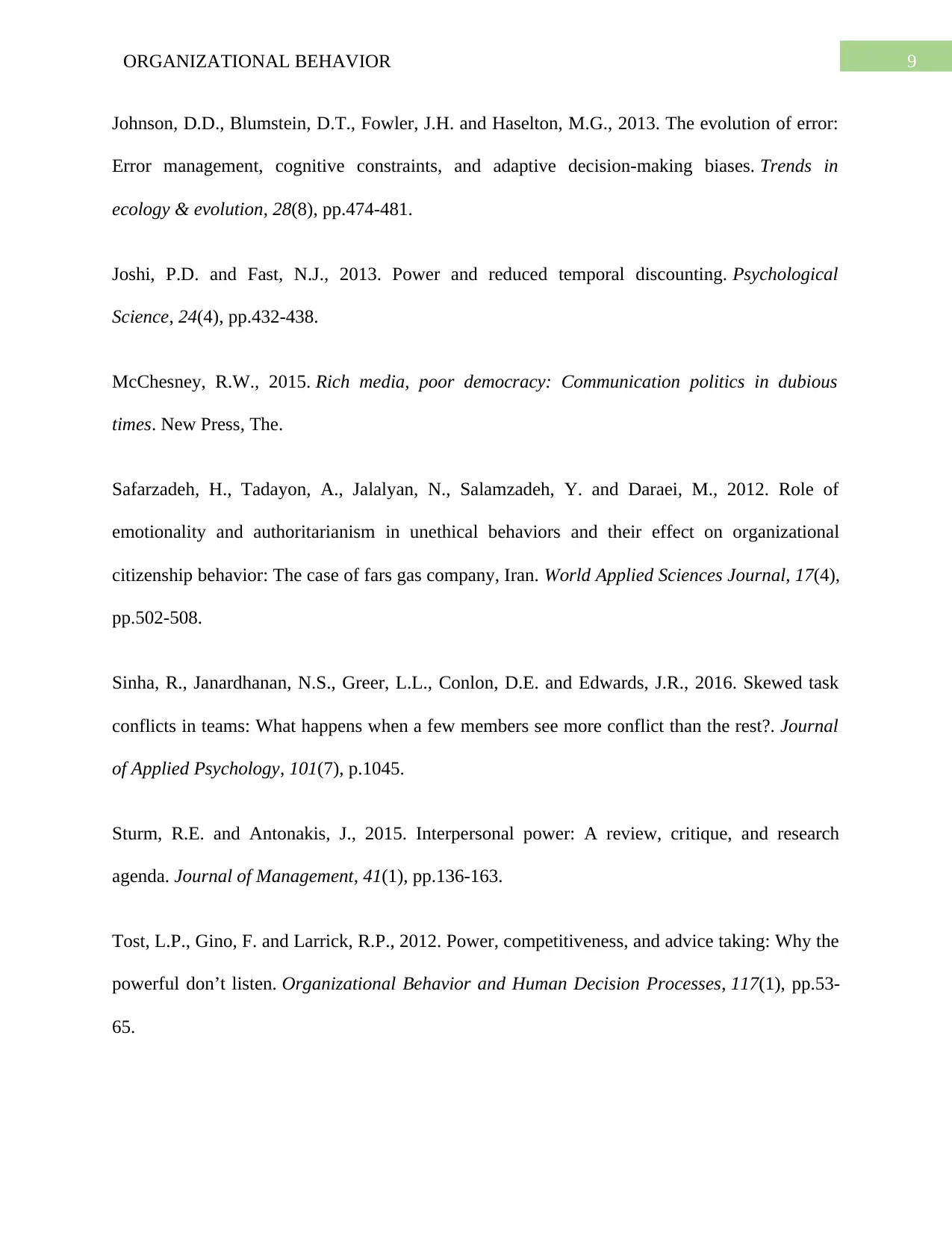
9ORGANIZATIONAL BEHAVIOR
Johnson, D.D., Blumstein, D.T., Fowler, J.H. and Haselton, M.G., 2013. The evolution of error:
Error management, cognitive constraints, and adaptive decision-making biases. Trends in
ecology & evolution, 28(8), pp.474-481.
Joshi, P.D. and Fast, N.J., 2013. Power and reduced temporal discounting. Psychological
Science, 24(4), pp.432-438.
McChesney, R.W., 2015. Rich media, poor democracy: Communication politics in dubious
times. New Press, The.
Safarzadeh, H., Tadayon, A., Jalalyan, N., Salamzadeh, Y. and Daraei, M., 2012. Role of
emotionality and authoritarianism in unethical behaviors and their effect on organizational
citizenship behavior: The case of fars gas company, Iran. World Applied Sciences Journal, 17(4),
pp.502-508.
Sinha, R., Janardhanan, N.S., Greer, L.L., Conlon, D.E. and Edwards, J.R., 2016. Skewed task
conflicts in teams: What happens when a few members see more conflict than the rest?. Journal
of Applied Psychology, 101(7), p.1045.
Sturm, R.E. and Antonakis, J., 2015. Interpersonal power: A review, critique, and research
agenda. Journal of Management, 41(1), pp.136-163.
Tost, L.P., Gino, F. and Larrick, R.P., 2012. Power, competitiveness, and advice taking: Why the
powerful don’t listen. Organizational Behavior and Human Decision Processes, 117(1), pp.53-
65.
Johnson, D.D., Blumstein, D.T., Fowler, J.H. and Haselton, M.G., 2013. The evolution of error:
Error management, cognitive constraints, and adaptive decision-making biases. Trends in
ecology & evolution, 28(8), pp.474-481.
Joshi, P.D. and Fast, N.J., 2013. Power and reduced temporal discounting. Psychological
Science, 24(4), pp.432-438.
McChesney, R.W., 2015. Rich media, poor democracy: Communication politics in dubious
times. New Press, The.
Safarzadeh, H., Tadayon, A., Jalalyan, N., Salamzadeh, Y. and Daraei, M., 2012. Role of
emotionality and authoritarianism in unethical behaviors and their effect on organizational
citizenship behavior: The case of fars gas company, Iran. World Applied Sciences Journal, 17(4),
pp.502-508.
Sinha, R., Janardhanan, N.S., Greer, L.L., Conlon, D.E. and Edwards, J.R., 2016. Skewed task
conflicts in teams: What happens when a few members see more conflict than the rest?. Journal
of Applied Psychology, 101(7), p.1045.
Sturm, R.E. and Antonakis, J., 2015. Interpersonal power: A review, critique, and research
agenda. Journal of Management, 41(1), pp.136-163.
Tost, L.P., Gino, F. and Larrick, R.P., 2012. Power, competitiveness, and advice taking: Why the
powerful don’t listen. Organizational Behavior and Human Decision Processes, 117(1), pp.53-
65.
1 out of 10
Related Documents
Your All-in-One AI-Powered Toolkit for Academic Success.
+13062052269
info@desklib.com
Available 24*7 on WhatsApp / Email
![[object Object]](/_next/static/media/star-bottom.7253800d.svg)
Unlock your academic potential
© 2024 | Zucol Services PVT LTD | All rights reserved.





